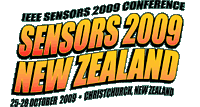

|
Tutorials Micro-Optic and Fiber Optic Sensors Terahertz Sensing Noise Harvesting Chemical and Gas Sensing Industrial Tomography Silicon Piezoresistive Stress Sensors Miniaturised Space Payloads Integrated Gas Sensors Sensors as Communication Channels Nanophotonic Sensors Biopolymer Detection Integrated Radar Sensors Ultrasonics |
Improvements in sensitivity, power consumption and/or packing density can be achieved by scaling sensor elements to nanoscale dimensions, and in some cases the unique physical phenomena that can occur at these dimensions can give rise to new sensing modalities. This tutorial will review developments that have been made in the field of nanophotonic and nanoelectronic sensors, with an emphasis on the fundamental principles of device operation. Biography Richard Blaikie received the B.Sc. (Hons) degree from the University of Otago, New Zealand, in 1988 and the Ph.D. degree in physics from the University of Cambridge, U.K., in 1992. For one year, he was a visiting scientist at the Hitachi Cambridge Laboratory, investigating single-electron transport effects in semiconductor nanostructures. He returned to New Zealand in 1993, taking up a position in the Department of Electrical and Computer Engineering at the University of Canterbury, where he is currently a Professor. Blaikie is also the Director of the MacDiarmid Institute for Advanced Materials and Nanotechnology, a multi-institutional New Zealand Centre of Research Excellence (www.macdiarmid.ac.nz). In 2005 was appointed by the Minister of Research, Science and Technology to serve on the Marsden Fund Council, which administers New Zealand's investigator-initiated research fund, and he served as the chair of the Physical Sciences and Engineering panel until early 2008. His principal research interests are the development of low cost nanolithography techniques using near field illumination, and the utilisation of sub-wavelength-structures at sub-mm and visible wavelengths. This applied electromagnetics research led to the award of the 2001 T.K. Sidey Medal of the Royal Society of New Zealand, and in 2005 he and colleague David Melville were the first to report experimental observation of the superlensing at optical wavelengths using thin silver films. His research interests also include polarisation modulation in optical communications systems, modelling of semiconductor device structures, and the application of nanofabrication techniques to new electronic, optical, chemical and biological devices. |
|||||||
Copyright 2008, All Rights Reserved, IEEE Sensors 2009 and interteq.com